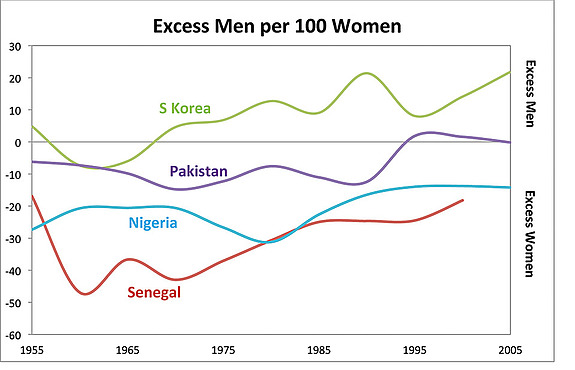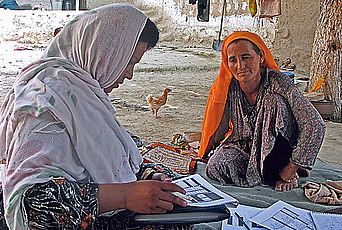Marriage Market Imbalances and the Position of Women

Women’s rights have come a long way since the beginning of the twentieth century. Before that, if a European or American woman were married, her husband owned the wages she might earn and controlled any property or inheritance she might bring. Women have also made major strides in developing countries. In India or China today, their position is a far cry from the past, when they may have been confined to the house or have their feet bound. Nonetheless, there are some puzzling steps backward. In India, the practice of dowry—payments made by the parents of the bride to the groom—has spread to parts of the country where it was earlier unknown. Dowry payments have also increased, despite laws banning the practice. In sub-Saharan Africa, polygyny persists and is socially acceptable despite modernization—Jacob Zuma’s four wives did not hinder his ascent to the Presidency of South Africa. Why has the forward march of women been interrupted in these developing countries? Is this trend likely to persist, or will it be reversed?
I argue that demographic trends, in interaction with the gap in the ages between men and their wives, provide an explanation. Men usually marry younger women—this is true in every country for which data is available, with an average gap ranging from two to seven years. For most of human history, the age gap has not mattered, since human populations have been stationary. However, as countries develop, birth cohorts start growing in size, at 2 percent or 3 percent a year. If the age gap at marriage is four years, the cohort of men born in a given year will be matched with the cohort of women born four years later and the latter cohort will be approximately 8–12 percent larger (assuming that the sex ratio within each cohort is balanced). This implies a very large excess of women on the marriage market, and one can expect adverse consequences for them, at marriage and later within the household, since their bargaining position is considerably reduced. This was the case in India in the second half of the twentieth century, and men were able to demand larger dowries. Parents came to perceive their daughters as a burden, especially given social norms that deemed it essential that they be married. The observed preference for boys in some parts of India may be attributable to these demographic trends, rather than innate son preference (although son preference is no doubt strong in northwest India). Similarly, in many sub-Saharan African countries, such as Senegal, birth cohorts are increasing at 2 percent per year, and this growth shows no signs of tapering off. Since these countries have a large gap at marriage, this magnifies the imbalance and provides ample opportunities for many men to indulge in polygyny.
But there is good news for women. These demographic trends have now been reversed in many countries. As women have become more educated and fertility has declined, cohorts have now started shrinking. This effect is most pronounced in East Asia, with cohort sizes in South Korea declining at 2–4 percent per year. Each cohort of men is now matched with a smaller cohort of women, giving rise to a shortage
of women. One should expect to see a significant improvement in the position of women, as their bargaining position improves. Trends in East Asia are indicators for the rest of the developing world. Cohort-size growth has now declined in other Asian countries and is turning negative. This is also true in the countries of the Arab Spring, such as Tunisia. The reversal of trend has major social consequences. As fertility declines further, and cohort sizes fall, not only can a woman paraphrase the Moroccan immigrant quoted at the start of this article and say to a man, “I am waiting for someone better,” but her improved options will improve her bargaining position and say within marriage.
An additional cause of gender imbalances is sex-selective abortions. Technological developments allow parents to ascertain the gender of the fetus. In countries where abortion is freely available, such as India and China, and where parents prefer boys, they are able to selectively abort female fetuses, giving rise to an unbalanced sex ratio at birth. In China, the 2010 census figures show 119 boy births per 100 girls, with some regions having 130–135 boys per 100 girls (as compared to the normal ratio of 105–106 boys per 100 girls). In India, while the overall figure is less unbalanced (109 in the 2011 census), some states in the northwest have ratios of 120.
The consequences for Chinese men are severe, if not catastrophic. As a consequence of the one-child policy, Chinese birth cohorts are falling at 5 percent per year, so that the excess of men due to sex-selective abortions is exacerbated. The cumulative imbalance is so large that one in five Chinese men born between the years 2000 and 2010 likely will not be able to find a partner. This is already causing major social changes in Chinese social life. For instance, Chinese couples are increasingly transferring more resources to the woman’s parents rather than the man’s. Chinese women can be choosier, and parents with a son are saving money to buy apartments, in order to improve his marriage prospects. Indeed, some economists suggest that marriage-market competition arising from the unbalanced sex ratio may be partially responsible for the enormous savings rate of Chinese households.
Why are Chinese parents so shortsighted that they continue to prefer boys even as this significantly reduces the likelihood that their sons will be able to marry? Chinese parents may prefer sons, but surely evolution has also imbued them with a desire for grandchildren? It turns out that the imbalance is not necessarily due to a lack of foresight but may well be an equilibrium consequence of son preference. Just as each commuter finds it optimal to take his car during rush hour, even though this clogs up the traffic and delays everyone else, so too Chinese parents clog up the marriage market with their excess of sons. Of course, even parents with gender-biased preferences would be better off if they had fewer sons, just as our commuters would be better off if they reduced their reliance on the automobile even slightly. But self-interest coupled with gender bias precludes such a rational solution. Governments can ban sex-selective abortions, but there remain formidable barriers to effective enforcement of such laws—since both ultrasound and abortions are legal, it is difficult to prevent sex-selective abortions.
I have argued here that a shortage of women, arising from demographic trends or sex-selective abortions, improves their bargaining position, just as an abundance of women has hurt them in the recent past. Some activists and social scientists argue differently—that a shortage of women will worsen their position, as they will be increasingly subject to trafficking, violence, and exploitation. These divergent views boil down to a more general question: does the owner of a resource become better off or worse off when the resource becomes scarce? If the owner of the resource is secure in his or her ownership, then she must be better off—she is no worse off if she keeps the resource for herself and will get better terms if she chooses to trade it. On the other hand, if property rights are not secure, then she may lose the resource when it becomes more valuable, since other parties have a greater incentive to grab it. For example, the indigenous people of the Amazon were harmed by the discovery of gold, since their lands became attractive to settlers. The question therefore turns on the security of women’s self-ownership. In societies where women have self-ownership—the right to make decisions about themselves and their bodies—increased scarcity will give them greater choice and make them better off. On the other hand, in a society such as Kyrgyzstan—where wife kidnapping is rife—scarcity could well make them worse off. The empirical evidence from many developing countries, including China and India, suggests that women have been harmed by their relative abundance. It also suggests that their position improves with scarcity. Nonetheless, this makes all the more compelling the case for legal protection guaranteeing women control over their bodies and their future and their right to make life choices
without coercion.


